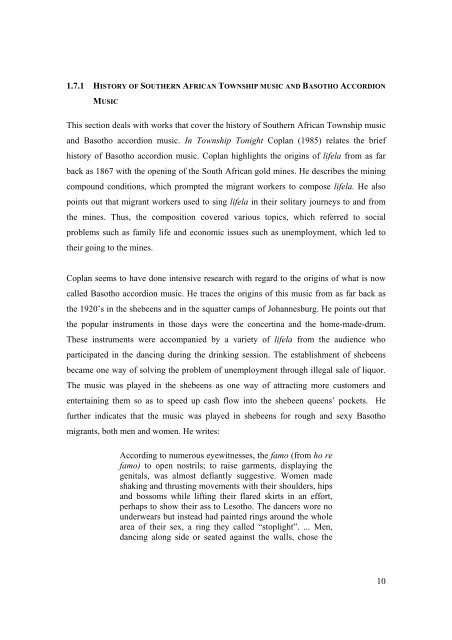Analysis of the language techniques and thematic - University of the ...
Analysis of the language techniques and thematic - University of the ...
Analysis of the language techniques and thematic - University of the ...
Create successful ePaper yourself
Turn your PDF publications into a flip-book with our unique Google optimized e-Paper software.
1.7.1 HISTORY OF SOUTHERN AFRICAN TOWNSHIP MUSIC AND BASOTHO ACCORDION<br />
MUSIC<br />
This section deals with works that cover <strong>the</strong> history <strong>of</strong> Sou<strong>the</strong>rn African Township music<br />
<strong>and</strong> Basotho accordion music. In Township Tonight Coplan (1985) relates <strong>the</strong> brief<br />
history <strong>of</strong> Basotho accordion music. Coplan highlights <strong>the</strong> origins <strong>of</strong> lifela from as far<br />
back as 1867 with <strong>the</strong> opening <strong>of</strong> <strong>the</strong> South African gold mines. He describes <strong>the</strong> mining<br />
compound conditions, which prompted <strong>the</strong> migrant workers to compose lifela. He also<br />
points out that migrant workers used to sing lifela in <strong>the</strong>ir solitary journeys to <strong>and</strong> from<br />
<strong>the</strong> mines. Thus, <strong>the</strong> composition covered various topics, which referred to social<br />
problems such as family life <strong>and</strong> economic issues such as unemployment, which led to<br />
<strong>the</strong>ir going to <strong>the</strong> mines.<br />
Coplan seems to have done intensive research with regard to <strong>the</strong> origins <strong>of</strong> what is now<br />
called Basotho accordion music. He traces <strong>the</strong> origins <strong>of</strong> this music from as far back as<br />
<strong>the</strong> 1920’s in <strong>the</strong> shebeens <strong>and</strong> in <strong>the</strong> squatter camps <strong>of</strong> Johannesburg. He points out that<br />
<strong>the</strong> popular instruments in those days were <strong>the</strong> concertina <strong>and</strong> <strong>the</strong> home-made-drum.<br />
These instruments were accompanied by a variety <strong>of</strong> lifela from <strong>the</strong> audience who<br />
participated in <strong>the</strong> dancing during <strong>the</strong> drinking session. The establishment <strong>of</strong> shebeens<br />
became one way <strong>of</strong> solving <strong>the</strong> problem <strong>of</strong> unemployment through illegal sale <strong>of</strong> liquor.<br />
The music was played in <strong>the</strong> shebeens as one way <strong>of</strong> attracting more customers <strong>and</strong><br />
entertaining <strong>the</strong>m so as to speed up cash flow into <strong>the</strong> shebeen queens’ pockets. He<br />
fur<strong>the</strong>r indicates that <strong>the</strong> music was played in shebeens for rough <strong>and</strong> sexy Basotho<br />
migrants, both men <strong>and</strong> women. He writes:<br />
According to numerous eyewitnesses, <strong>the</strong> famo (from ho re<br />
famo) to open nostrils; to raise garments, displaying <strong>the</strong><br />
genitals, was almost defiantly suggestive. Women made<br />
shaking <strong>and</strong> thrusting movements with <strong>the</strong>ir shoulders, hips<br />
<strong>and</strong> bossoms while lifting <strong>the</strong>ir flared skirts in an effort,<br />
perhaps to show <strong>the</strong>ir ass to Lesotho. The dancers wore no<br />
underwears but instead had painted rings around <strong>the</strong> whole<br />
area <strong>of</strong> <strong>the</strong>ir sex, a ring <strong>the</strong>y called “stoplight”. ... Men,<br />
dancing along side or seated against <strong>the</strong> walls, chose <strong>the</strong><br />
10

















